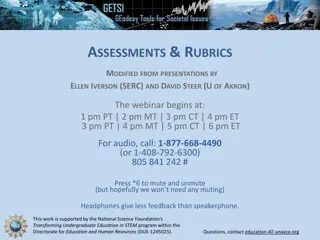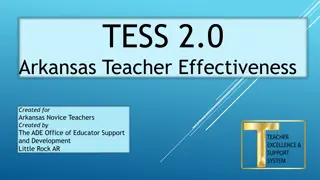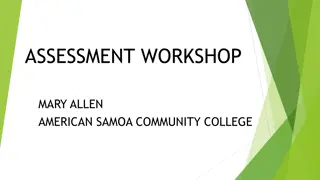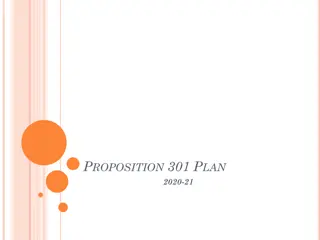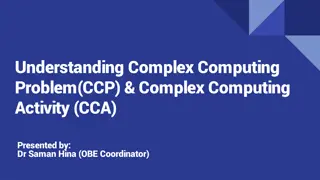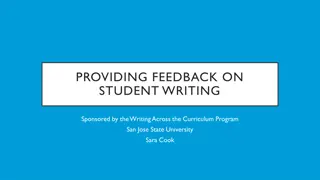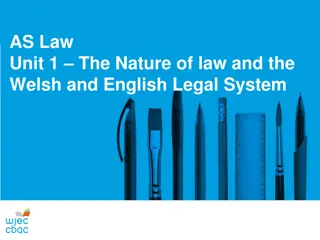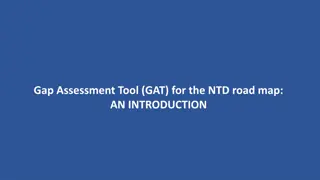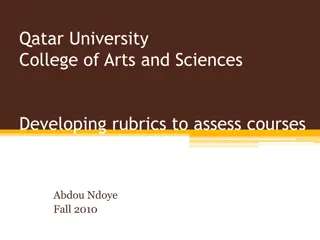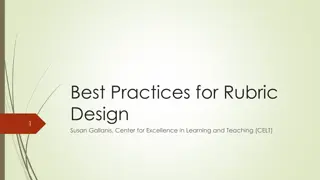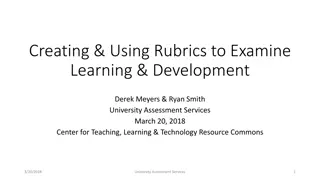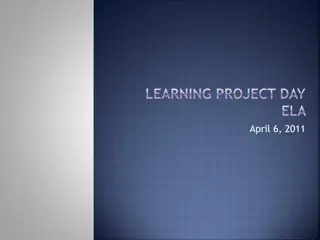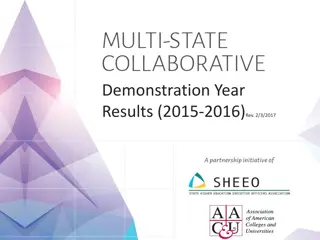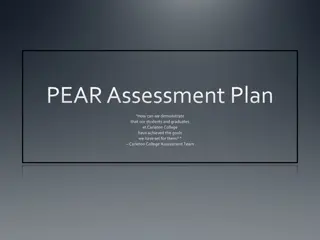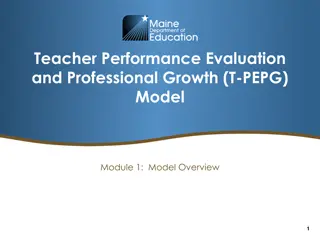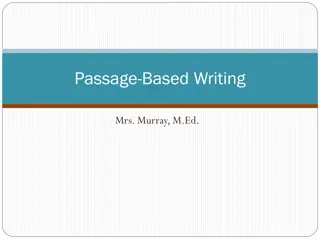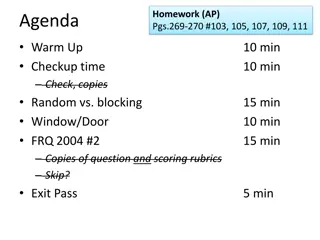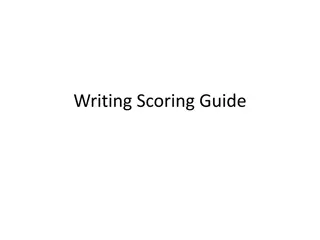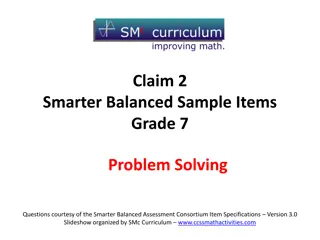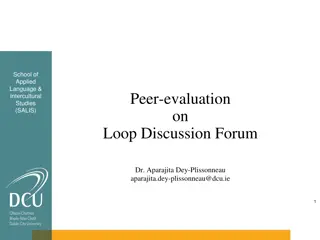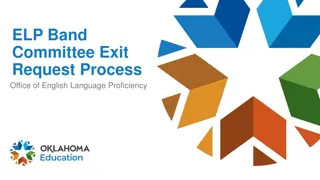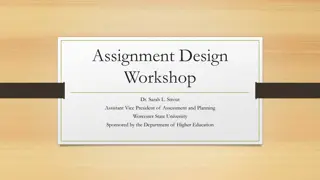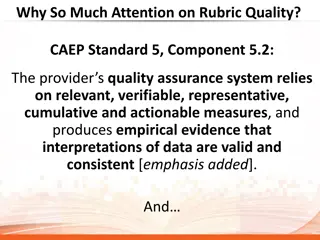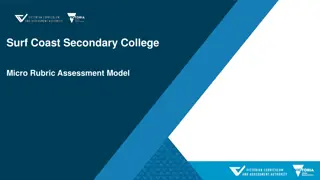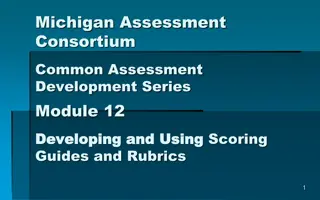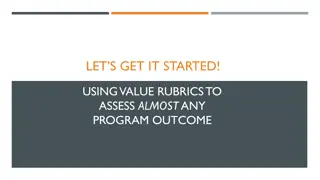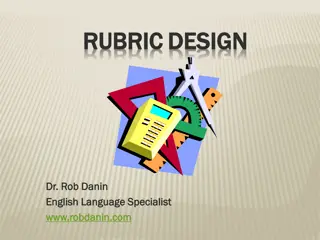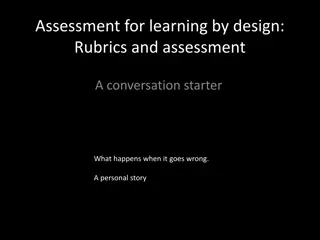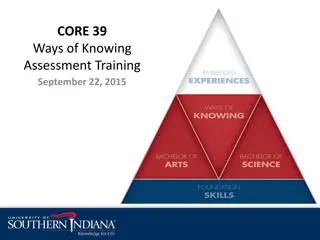Action Research Data Collection Methods Overview
Explore quantitative data collection methods such as checklists, rubrics, surveys, and rating scales for action research in education. Learn how these tools are used to assess student performance and gather valuable insights for refining teaching strategies. Discover the key characteristics and appl
4 views • 12 slides
Review of Grading Practices in PWCS and BRMS
This document outlines the assessment and grading practices in Prince William County Schools (PWCS) and Bull Run Middle School (BRMS) with a focus on providing feedback, enhancing student learning, and aligning assessments with learning outcomes. It includes information on assessment purposes, forma
3 views • 12 slides
ASSESSMENTS & RUBRICS
Enhance your understanding of assessments and rubrics in STEM education through a comprehensive webinar covering terminology, proposal strategies, and practical usage of materials design rubrics. Delve into setting learning goals, aligning outcomes, and designing instructional strategies for success
1 views • 25 slides
Understanding TESS 2.0: A Guide for Arkansas Novice Teachers
Explore the Teacher Effectiveness Support System (TESS) 2.0 specifically designed for novice teachers in Arkansas. Learn about effective teaching methods, guiding improvement through rubrics, and the essential components of teacher excellence outlined in the ESSA. Dive into the TESS framework, its f
1 views • 31 slides
Assessment Workshop at American Samoa Community College
Explore the process of assessment, including topics like rubrics, reliability, validity, data analysis, direct vs. indirect assessments, and examples of learning outcomes. Discover the strengths and methods of creating rubrics to evaluate student work effectively.
0 views • 74 slides
Proposition 301 Plan Overview for Teacher Compensation
The Proposition 301 Plan for the 2020-21 academic year outlines a structured approach to pay increases for teachers. It includes three components: a 20% increase to base salary, 40% for meeting performance goals, and 40% for duties fulfilled from a set list of menu items. The plan also details speci
0 views • 19 slides
Mastering AP Government FRQs: Tips for Success
Understanding the differences between FRQs and essays, grading rubrics, answering questions effectively, deciphering action verbs, and interpreting common task instructions for AP Government exam success.
1 views • 28 slides
Understanding Complex Computing Problem (CCP) and Complex Computing Activity (CCA)
Dr. Saman Hina, along with Dr. Farrukh Arif and Dr. Maria Waqas, presents information on Complex Computing Problem (CCP) - a problem involving technical, computing, and other issues with no obvious solution, requiring deep knowledge and analytical thinking. CCP is evaluated through predefined rubric
4 views • 19 slides
Enhancing Student Writing: Effective Feedback Strategies
Enhance student writing through effective feedback strategies sponsored by the Writing Across the Curriculum Program at San Jose State University. The feedback process is viewed as an opportunity to teach, emphasizing strengths, weaknesses, and improvement areas for students. Designing clear instruc
0 views • 60 slides
Understanding the Rule of Law and Legal Systems in Wales and England
The content discusses the nature of law, the Welsh and English legal systems, and the Rule of Law doctrine. It includes observations from the 2019 AS Law Unit 1 examination, emphasizing the importance of adhering to rubrics and answering questions clearly. Candidates faced challenges with timing and
0 views • 14 slides
Advancing NTD Roadmap through the 2022 Gap Assessment Tool (GAT) Introduction
Introducing the Gap Assessment Tool (GAT) for the NTD roadmap, focusing on disease-specific assessments like Schistosomiasis. The 2022 GAT aims for greater standardization and objectivity in assessment criteria across diseases with specific rubrics defined for each dimension.
0 views • 18 slides
Rubrics and Authentic Assessments in Course Evaluation at Qatar University
Workshop focused on developing rubrics for assessing courses at Qatar University College of Arts and Sciences. It covers the rationale for using rubrics, different assessment types, challenges of authentic assessment, and the role of rubrics in ensuring consistency and reliability in evaluating stud
0 views • 14 slides
Best Practices for Rubric Design in Teaching
Explore the key components of rubrics, understand their importance in assessment, and learn how to effectively design and use them to enhance student learning outcomes.
0 views • 18 slides
Understanding and Utilizing Rubrics for Assessment
A rubric is a scoring tool that outlines specific expectations for evaluating assignments or projects. This tool helps in identifying key criteria for assessment and provides a structured approach to grading. Rubrics play a vital role in enhancing learning outcomes and promoting consistency in evalu
0 views • 26 slides
Enhancing Feedback Strategies in ELA Learning Project Day
Refine understanding of ELA, engage with student exemplars, and design constructive feedback in a structured agenda. Activities include generating feedback, digging deeper into feedback processes, and considering the impact of timely and specific feedback on student growth in learning and skills. Co
0 views • 31 slides
Multi-State Collaborative for Advancing Quality Student Learning
Slides showcasing results from the demonstration year (2015-2016) of the Multi-State Collaborative for Advancing Quality Student Learning involving 12 states. Study findings reflect the use of common rubrics to assess student work and highlight the challenges and benefits of the VALUE rubrics. Facul
2 views • 32 slides
Carleton College Assessment Plan for P.E.A.R. Programs
Carleton College aims to assess the achievement of student learning goals in its P.E.A.R. programs through identifying learning outcomes, developing assessment measures, collecting evidence, and reviewing results using tools like surveys and rubrics. The focus is on skill acquisition, knowledge enha
0 views • 13 slides
Teacher Performance Evaluation and Professional Growth (T-PEPG) Model Overview
This training module provides an in-depth look at the Teacher Performance Evaluation and Professional Growth (T-PEPG) model, focusing on key features, structure, and terminology of the MSFE rubric. Participants will explore self-assessment, reflection, goal-setting, student learning objectives, evid
0 views • 40 slides
Developing Skills for Effective Passage-Based Writing
Enhance writing proficiency by focusing on skills such as flow of ideas, word choice, audience awareness, story structure, sentence structure, punctuation, and more. Learn about informative rubrics for evaluating writing quality and different types of schmicken.
3 views • 30 slides
Comprehensive Guide to Kindergarten Writing Training for NYSESLAT 2019
Explore a detailed guide on Kindergarten Writing Training for the NYSESLAT 2019 exam. The training covers four constructed-response types including Letter Writing, Word Writing, Sentence Writing, and Writing a Story. Gain insights into the application of holistic writing rubrics, analyzing student r
0 views • 24 slides
Strategic Learning Outcomes and Assessment Plan at SCSU
Strategic overview of St. Cloud State University's commitment to institutional learning outcomes, assessment plan implementation, governance structure, oversight committee, and tools used for evaluation such as rubrics and surveys. Emphasis on student graduation goals and educational values.
0 views • 28 slides
AP Statistics Homework Agenda and Experimental Design Example
In this AP Statistics homework agenda, students work on warm-up questions, checkups, and a controlled experiment design example involving paper airplanes and natural light impact on test scores. The agenda covers various topics such as confounding variables, random vs. blocking, and controlled exper
0 views • 15 slides
Analysis of Writing Scoring Guide Study Results
This study on writing scoring guide analyzed 594 writing samples using both draft and official scoring rubrics. Results showed varied passing rates between draft and official scoring, with a focus on mean trait scores and agreement levels. The study also delved into sentence fluency editing. Through
0 views • 8 slides
Grade 7 Smarter Balanced Sample Problem-Solving Questions
Get ready to solve challenging Grade 7 math problems with these sample questions from the Smarter Balanced Assessment Consortium. Test your problem-solving skills with questions on bank account balances, gas mileage, marching band members, and more. Check your answers against the provided answer rub
0 views • 35 slides
Government Advocacy Project Guidelines
Engage in a government advocacy project by researching a current student-related issue, drafting a letter to a government official, and reflecting on your work. Follow steps for success, choose from various topics, and adhere to evaluation rubrics for thorough research and meaningful reflections.
0 views • 19 slides
Crafting Fundable Research Grants: Tips and Strategies
Crafting fundable research grants requires concise project summaries, inviting narratives, and alignment with review rubrics. Understanding the differences between grant types and following post-award processes are key to success in securing funding.
0 views • 21 slides
Peer Evaluation Strategies in SALIS Language Module
Explore the peer evaluation methods used in the School of Applied Language & Intercultural Studies (SALIS) for the FR376 French module. The approach includes criteria such as linguistic quality, interaction management, and drawing lessons for future productions. Rubrics on Loop Forum aid in assessin
0 views • 21 slides
Competitive Event Preview 2019-2020 Updates and Guidelines
In the Competitive Event Preview 2019-2020, various updates and guidelines have been announced. Changes include time remaining announcements in all events, the addition of calculators and scratch paper in certain subjects, and updates to rubrics. Middle school event updates cover medical terminology
0 views • 42 slides
Understanding the ELP Band Committee Exit Process for English Language Proficiency
Explore the ELP Band Committee Exit Process for English Language Proficiency, an alternate path for students to demonstrate language skills and exit EL status. Topics covered include automatic exit scores, requirements, documentation, rubrics, and more. Discover the criteria for both ACCESS and Alte
0 views • 29 slides
Enhancing Student Success Through Inclusive Assignment Design
Effective assignment design is crucial for student success, particularly for first-generation and underrepresented students. Clear instructions, transparent rubrics, and inclusive assessment approaches are key factors in promoting learning outcomes and reducing biases. Inclusive assignments should a
0 views • 15 slides
Enhancing Rubric Quality in Educational Assessment
The focus on rubric quality in education, particularly in meeting CAEP Standard 5, Component 5.2 for quality assurance systems, is crucial for generating valid, reliable, and actionable data. CAEP now allows early submission of assessment instruments to improve data quality. However, common weakness
0 views • 22 slides
Understanding Constructed Response Items in Education
Exploring the concept of constructed response items in education, this content delves into the complexities of student responses, assessment for learning, rubric development, and differentiation strategies. Richard Woods, Georgia's School Superintendent, provides insights on how to navigate through
0 views • 31 slides
Understanding Micro Rubrics in Educational Assessment
A micro rubric is a detailed assessment tool used at the end of learning activities to evaluate student performance and guide self-reflection. It consists of levels ranging from "Not Submitted" to "Excelling" and helps students improve their work through targeted feedback. Micro rubrics differ from
0 views • 6 slides
Mastering Rubrics: Types, Design, and Application
Understand the essentials of rubrics by exploring various types like checklists, rating scales, Likert-type scales, holistic, and analytic rubrics. Learn about the characteristics of good rubrics and how to create effective scoring guides. Get insights from examples like the University of Pittsburgh
0 views • 9 slides
Developing and Using Scoring Guides and Rubrics in Assessment
Explore the importance of rubrics and scoring guides in assessment development, understanding different types of rubrics, developing and using them effectively, and addressing bias through objective criteria. Learn how rubrics help in evaluating student responses and providing feedback for improveme
0 views • 52 slides
Understanding Value Rubrics for Comprehensive Program Assessment
Explore the use of VALUE rubrics for assessing program outcomes, creating aligned assignments, collecting student work effectively, and improving student skills. Learn about AAC&U's 15 VALUE rubrics and their applications in course and program evaluation. Discover how to define performance level
0 views • 24 slides
Mastering Rubric Design for Effective Assessment
Rubrics are essential tools in evaluating and providing feedback on student performance. This comprehensive guide covers the definition, elements, and benefits of rubrics, along with expert tips on designing impactful rubrics for various assessments. Explore the art of rubric design, learn what make
0 views • 30 slides
Enhancing Assessment Practices Through Rubrics and Conversational Learning
Explore the critical aspects of rubrics in assessment design, including the distinction between holistic and analytical rubrics, their respective applications, and how they can be leveraged as learning tools. Discover the importance of aligning rubrics with course objectives and engaging students in
0 views • 10 slides
Streamlining the CORE 39 Assessment Process: A Closer Look at Rubrics and Deadlines
A detailed insight into the CORE 39 assessment process, focusing on the creation of rubrics aligned with key assignments. Learn about the formation of the CORE 39 Assessment Task Force and the use of Tk20 software for assessment. Important deadlines and the role of rubrics in grading are highlighted
0 views • 23 slides
Enhancing Assessment Practices through Effective Rubrics Design
Explore the importance of well-designed rubrics in assessment practices, focusing on avoiding pitfalls and maximizing student understanding. Learn how to create powerful rubrics that guide students towards essential learning outcomes. Gain insights on improving assessment strategies and fostering cl
0 views • 17 slides


